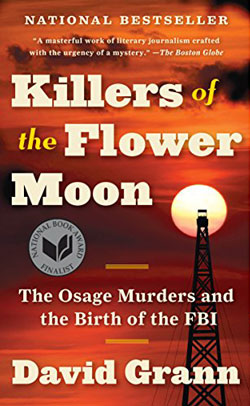
David Grann’s award winning non-fiction book about the murders of numerous members of the Osage Tribe is a compelling read.
Maybe five years ago I had a call from David Grann. He introduced himself as a reporter for The New Yorker who was investigating the Osage murders in Oklahoma during the 1920s. He was particularly interested in three men from Hunt County: Will King Hale, Ernest Burkhart, and his brother Bryan Burkhart. Ironically I was looking for Wade Hampton Wallace, also from Hunt County who was electrocuted during a thunderstorm in Oklahoma, either in Osage County or Tulsa County. I agreed to include the Burkhart brothers and Will K. Hale in my research.
What I found was some of the most horrific, cruel, savage contempt for humanity known. Will King Hale did live in Hunt County, between Ardis Heights and Campbell as a child. His sister married a man whose last name was Burkhalter. The couple had at least two sons, Bryan and Ernest. When and why the brothers named was changed is unknown.
Will King Hale wandered around Texas and then Indian Territory for several years before settling in Osage County. He worked as a cowboy and earned money on the side as a rodeo roper before purchasing a ranch of his own there. That was about the time, Hale invited his nephews to join him on the ranch.
At that point in my research I discovered that Wade Hampton Wallace from Greenville did not live in Osage County, Oklahoma, but in Tulsa where he was an engineer for the city. To this date I have no idea who the other Wade Hampton Wallace living in Osage County was.
While I was researching for Mr. Grann, I found official records only recently released online by the FBI. As I read them, I was amazed at the atrocities recorded in the investigation. Mr. Grann was satisfied with my research, a common task for local historians who have more insight into their communities than the author. I went on to other projects, occasionally thinking about why those murders might have occurred, although I was aware of the immense oil field under the dry, scraggy pasture lands the Osage were forced to live on.
Last summer I was in my favorite bookstore in the whole, wide world, The Strand on lower Broadway in New York City. I saw a copy of Killers of the Flower Moon: The Osage Murders and the Birth of the FBI. As I was scanning through it, a clerk came to talk to me about the book. I mentioned that I was one of the researchers of Will K. Hale and the Burkhart brothers. The clerk then told me the work was nominated for several book awards and had won most. It was at the top of the New York Times Best Seller List. I was definitely impressed!
The book is divided into three parts. The first, “The Marked Woman,” tells of the murders of Osage tribe members. The second part, “The Evidence Man,” reveals the FBI investigation. Finally, “The Reporter” is the most climatic. The book is definitely a page-turner. Grann writes like a polished novelist. I highly recommend it for everyone. You will shake your head and say, “How could this have happened?”
But maybe you know.

Carol, how interesting and how cool to see that book in a store in NYC! Will have to read it! Great article.